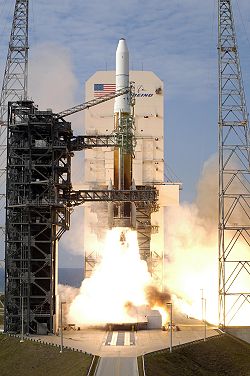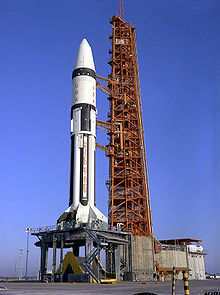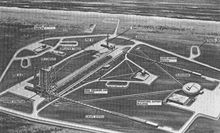- Cape Canaveral Air Force Station Space Launch Complex 37
-
Space Launch Complex 37 
The launch of GOES-N atop a Delta IV, from SLC-37B in 2006Launch site Cape Canaveral Air Force Station Location 28.531986°N
80.566821°WShort name SLC-37 Operator US Air Force Total launches 25 Launch pad(s) 2 Minimum / maximum
orbital inclination28° - 57° LC-37A launch history Status Demolished Launches 0 First launch Unused Associated rockets Saturn I
Saturn IBSLC-37B launch history Status Active Launches 25 First launch 29 January 1964
Saturn I / SA-5Last launch 16 July 2011
Delta IV / USA-232Associated rockets Saturn I
Saturn IB
Delta IV (current)Cape Canaveral Air Force Station Space Launch Complex 37[1][2] (SLC-37), previously Launch Complex 37 (LC-37), is a launch complex on Cape Canaveral, Florida. Construction began in 1959 and the site was accepted by NASA to support the Saturn I program in 1963.[3] The complex consists of two launch pads. LC-37A has never been used, but LC-37B launched unmanned Saturn I flights (1964 to 1965) and was modified and launched Saturn IB flights (1966 to 1968), including the first (unmanned) test of the Apollo Lunar Module in space.[3] It was deactivated in 1972. In 2001 it was modified as the launch site for Delta IV, a launch system operated by United Launch Alliance.
 Apollo 5 on LC-37B
Apollo 5 on LC-37B
The first launch to utilize the complex was the SA-5 unmanned test of the Saturn I launch vehicle. It was closed in 1968, following the unmanned Apollo flight Apollo 5, but re-opened in 2002 as a Delta IV launch site, and is in active use for that launch system.
The original layout of the launch complex featured one Mobile Service Structure which could be used to service or mate a rocket on either LC-37A or 37B, but not on both simultaneously. The Delta IV Mobile Service Tower is 330 ft (100 m) tall.[4]
Contents
Launch history
Saturn
All flights operated by NASA.
Date Launch vehicle Payload Mission/function Remarks Jan. 29, 1964 Saturn I none SA-5 First live S-IV econd stage May 28, 1964 Saturn I BP-13 boilerplate CSM A-101 (SA-6) First boilerplate CSM Sept. 18, 1964 Saturn I BP-15 boilerplate CSM A-102 (SA-7) Feb. 16, 1965 Saturn I Pegasus A and BP-16 boilerplate CSM A-103 (SA-9) Pegasus studied micrometeoroid impacts May 25, 1965 Saturn I Pegasus B and BP-26 boilerplate CSM A-104 (SA-8) July 30, 1965 Saturn I Pegasus C and BP-9A boilerplate CSM A-105 (SA-10) July 5, 1966 Saturn IB none AS-203 Test of S-IVB; informally called Apollo 2 Jan. 22, 1968 Saturn IB LM-1 Apollo 5 Test of the first lunar module Delta
-
This list is incomplete; you can help by expanding it.
See also
- List of spaceflights by year
- List of Cape Canaveral and Merritt Island launch sites
- Project Apollo
- Cape Canaveral Air Force Station Launch Complex 34
References
- ^ McDowell, Jonathan (1998-02-22). "Issue 350". Jonathan's Space Report. Jonathan's Space Page. http://planet4589.org/space/jsr/back/news.350. Retrieved 2009-07-09.
- ^ DELTA-IV HEAVY TO LAUNCH LAST DSP SATELLITE
- ^ a b "Complex 37 -- Cape Canaveral Air Station". Federation of American Scientists (www.fas.org). 2000-06-16. http://fas.org/spp/military/facility/ccas-lc-37.htm. Retrieved 2008-05-28.
- ^ "Boeing, Raytheon Top Off Nation's Newest Launch Tower". Boeing. March 2, 2000. http://www.boeing.com/news/releases/2000/news_release_000302h.html.
External links
Coordinates: 28°31′55″N 80°34′01″W / 28.531986°N 80.566821°W
Cape Canaveral and Merritt Island launch sites Atlantic Missile Range drop zone • Grand Turk Island drop zone • Mobile Launch Area • SLBM Launch Area • Patrick AFB • Shuttle Landing Facility • Cape Canaveral AFS Skid StripCategories:- Apollo program
- Buildings and structures in Brevard County, Florida
- Cape Canaveral Air Force Station
-
Wikimedia Foundation. 2010.


